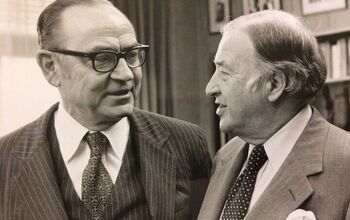Ford Touts "New Whiz Kids"
Unlike Chrysler and GM, Ford has managed to minimize the downward depreciation spiral that’s been plaguing business models across Detroit. In fact, FoMoCo has increased its net pricing by $1.9b in the first half of this year alone. Ford explains this achievement with a reach back to history: a team of 19 P.H.D.s tasked with managing pricing, production and option mixes is given credit, and compared with the “Whiz Kids” of the post-war era in the Detroit News. “They are unbelievable,” gushes Ford’s Jim Farley. “It’s very scientific. I’ve never seen anything like it in our industry.” The Global Lifecycle Analytics Department (GLAD) was formed in 2000, as a modern-day equivalent to the statistical analysis pioneers hired to bring Ford back from the brink of oblivion in the 1940s. By 2005 the team, led by Rose “The Silent Lamb” Peng, had figured out that “the resale value of Ford’s cars and trucks was being eroded by sales of poorly contented vehicles to rental agencies.” Go figure. Let’s hear it for statistical analysis.
Instead of just trying to sell the vehicles to push up volume, we are actually giving the customer higher value with their product and pulling back incentives. At the end of the day, they will have lower cost of ownership and higher residual value.
And how did GLAD reach these conclusions about product mix and strategy? “Before, it was more art than science. Now it is definitely more science-based,” says Peng. And though Ford is spinning GLAD’s achievements as a triumph of neo-Whiz Kiddery, the emphasis on science seemed to yield results that make sense on the good, old-fashioned common sense level. And a rule-by-spreadsheet can have its downsides. Just ask the current batch of Wall Street “Whiz Kids.” Or the original Whiz Kid, Jack Reith, who “scientifically determined ” that Ford needed a new mid-range brand, a calculation that ended up in the Edsel debacle. And I’m not even going to touch the Vietnam War or the transition at Ford to an architectonic corporate panopticon (for obvious reasons).
All the same, results do speak for themselves. And like all things Ford, those results look good… when compared to GM and Chrysler. Can you imagine GM’s Susan Docherty poring over spreadsheets for hours, or earning the nickname “Silent Lamb”? Besides, even Peng admits that the Whiz Kid allusion is pure Ford PR. “I don’t think we can compare ourselves with them,” she says. “It is enough of a reward for us when the company uses our models.” Which is something no original Whiz Kid, a pack of high-flying, we-know-best executives, would have ever been caught dead telling a newspaper.
More by Edward Niedermeyer
Latest Car Reviews
Read moreLatest Product Reviews
Read moreRecent Comments
- MaintenanceCosts Nobody here seems to acknowledge that there are multiple use cases for cars.Some people spend all their time driving all over the country and need every mile and minute of time savings. ICE cars are better for them right now.Some people only drive locally and fly when they travel. For them, there's probably a range number that works, and they don't really need more. For the uses for which we use our EV, that would be around 150 miles. The other thing about a low range requirement is it can make 120V charging viable. If you don't drive more than an average of about 40 miles/day, you can probably get enough electrons through a wall outlet. We spent over two years charging our Bolt only through 120V, while our house was getting rebuilt, and never had an issue.Those are extremes. There are all sorts of use cases in between, which probably represent the majority of drivers. For some users, what's needed is more range. But I think for most users, what's needed is better charging. Retrofit apartment garages like Tim's with 240V outlets at every spot. Install more L3 chargers in supermarket parking lots and alongside gas stations. Make chargers that work like Tesla Superchargers as ubiquitous as gas stations, and EV charging will not be an issue for most users.
- MaintenanceCosts I don't have an opinion on whether any one plant unionizing is the right answer, but the employees sure need to have the right to organize. Unions or the credible threat of unionization are the only thing, history has proven, that can keep employers honest. Without it, we've seen over and over, the employers have complete power over the workers and feel free to exploit the workers however they see fit. (And don't tell me "oh, the workers can just leave" - in an oligopolistic industry, working conditions quickly converge, and there's not another employer right around the corner.)
- Kjhkjlhkjhkljh kljhjkhjklhkjh [h3]Wake me up when it is a 1989 635Csi with a M88/3[/h3]
- BrandX "I can charge using the 240V outlets, sure, but it’s slow."No it's not. That's what all home chargers use - 240V.
- Jalop1991 does the odometer represent itself in an analog fashion? Will the numbers roll slowly and stop wherever, or do they just blink to the next number like any old boring modern car?






























Comments
Join the conversation